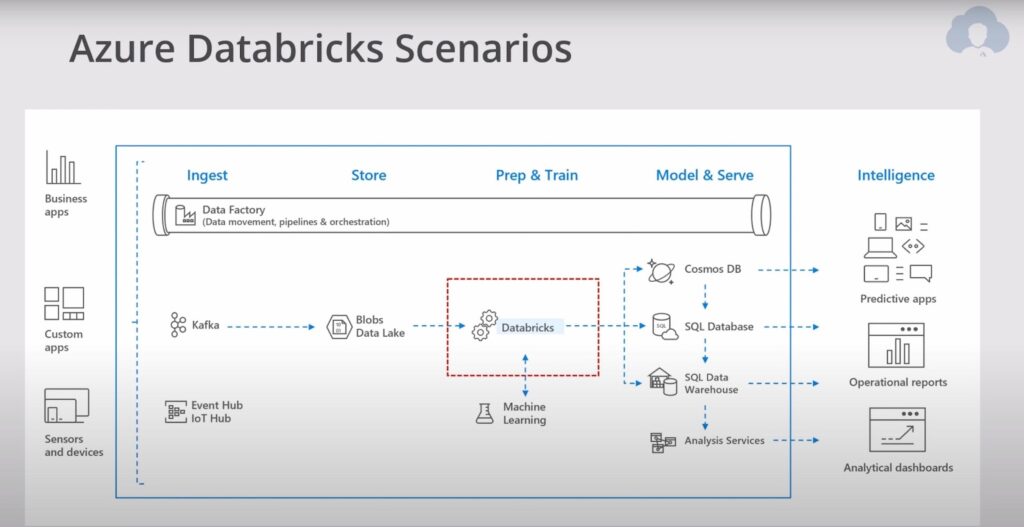Databricks is a renowned software company, primarily celebrated for its role in developing Apache Spark, a powerful open-source unified analytics engine. The company’s portfolio boasts a range of highly successful software, pivotal in the realms of data engineering, data science, and machine learning. Some of their most prominent offerings include Delta Lake, MLflow, and Koalas. Central to Databricks’ ethos is the development of web-based platforms that integrate seamlessly with Spark, featuring automated cluster management and IPython-style notebooks.
Azure Databricks: A Unified Data Platform
Azure Databricks stands out as a comprehensive, unified platform within the Microsoft Azure ecosystem, designed to cater to the needs of data scientists, engineers, and analysts. It provides a highly collaborative environment conducive to both interactive and scheduled data analysis workloads. Key features of Azure Databricks include:
- Databricks Structured Query Language (SQL): A serverless data warehouse component that excels in running SQL and BI applications with enhanced optimizations for improved price/performance;
- Data Science and Engineering Environment: Offers an interactive workspace for data professionals, allowing for diverse data integration methods such as batch infusions through Azure Data Factory and real-time streaming via tools like Apache Kafka;
- Machine Learning Capabilities: A comprehensive machine-learning suite providing services for experimentation, model training, feature development, and model management, including model serving.
Advantages and Disadvantages of Azure Databricks
Advantages:
- Data Sharing and Integration: Being part of Azure facilitates extensive data sharing;
- Ease of Setup and Configuration: Simplified cluster setup and management;
- Diverse Language Support: Compatible with multiple programming languages including Scala, Python, SQL, and R;
- Integration with Azure Ecosystem: Seamless connectivity with Azure DB and integration with Active Directory.
Disadvantages:
- Limited Support for Azure Services: Current support is confined to HDInsight, excluding Azure Batch or AZTK.
Top Reasons to Use Azure Databricks
Familiar Programming Environment
One of the top reasons to use Azure Databricks is its support for familiar programming languages such as Python and R. This aspect is particularly beneficial as it significantly reduces the learning curve for developers who are already conversant with these languages. Azure Databricks ensures that users do not have to invest time and resources in learning new programming languages. By providing a platform where commonly used languages are readily applicable, Azure Databricks makes it easier for teams to adapt and integrate this tool into their existing workflows. The backend APIs of Azure Databricks facilitate smooth interaction with Spark, further enhancing the efficiency of development processes.
Enhanced Productivity and Collaboration
Azure Databricks excels in creating an environment that is conducive to both productivity and collaboration. This is achieved through the streamlined deployment processes and a Software-as-a-Service (SaaS) workspace that simplifies collaboration across teams. The deployment from work notebooks to production is seamless, involving only minor modifications such as adjusting data sources and output directories. This ease of transition from development to production is a key factor in accelerating project timelines and enhancing team productivity. Moreover, the collaborative features of the Databricks workspace allow for easier sharing of notebooks, libraries, and experiments, fostering a more collaborative and integrated approach to data science and engineering projects.
Versatile Data Source Connectivity
Azure Databricks is notable for its ability to connect with a diverse range of data sources, not limited to those within the Azure ecosystem. This versatility is crucial for organizations dealing with varied data sources, including on-premise SQL servers, CSV and JSON files, and databases like MongoDB, Avro, and Couchbase. Such extensive compatibility ensures that Azure Databricks can be effectively integrated into virtually any data architecture, making it a highly adaptable and flexible tool for data processing and analytics.
Scalability for Different Job Sizes
Another compelling reason to opt for Azure Databricks is its scalability, accommodating a wide spectrum of job sizes. It is proficient not only in handling massive analytics jobs but also in managing smaller-scale development and testing work. This flexibility eliminates the necessity for separate environments or virtual machines for development purposes, positioning Azure Databricks as a comprehensive solution for all analytics-related tasks, irrespective of their scale. This scalability is especially valuable in dynamic environments where requirements can vary significantly.
Robust Documentation and Support
Lastly, Azure Databricks is supported by massive documentation and online support resources, reflecting its longstanding presence in the industry. Despite being a relatively new addition to the Azure suite, Databricks has a rich history and a well-established user base. This means that users can easily access a wealth of information and support for all aspects of Databricks, from setup and configuration to advanced programming techniques. Such robust support is indispensable, particularly for organizations venturing into new territories of data analytics and machine learning, ensuring a smoother and more informed implementation process.

Conclusion
Azure Databricks emerges as a potent and cost-effective tool in the expanding domain of big data technology. Its blend of flexibility, user-friendliness, and comprehensive feature set makes it an ideal choice for organizations looking to harness the power of distributed analytics. As the digital landscape evolves, Azure Databricks is poised to be an indispensable asset for data-driven enterprises.
